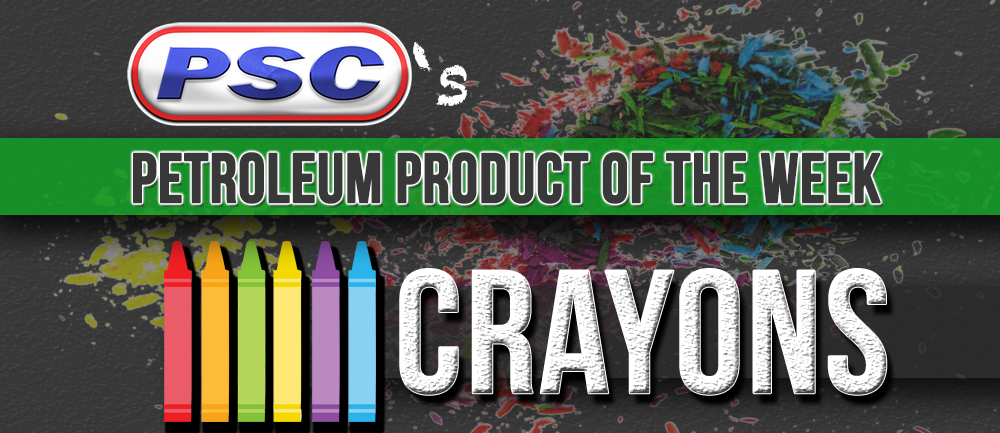Petroleum Product of the Week: How Crayons are Made
By on May 06 2016

Crayons are a kid's best friend
Ah, the joys of childhood: recess, nap time, virtually no responsibilities, and coloring. Take me back, right? Who doesn't want a chocolate chip cookie and a carton of milk before being tucked into bed at 1 o'clock in the afternoon?
If there's one nostalgic artifact from the collective unconscious of an American childhood, it has to be the crayon.

These smooth little sticks of rainbow wax wrapped in paper bearing such positively fun names like Fuzzy Wuzzy, " Jazzberry Jam, " and Banana Mania " (if your parents splurged on Crayola brand crayons, that is) still remain the quintessential tool for childhood and early education after hundreds of years.
So what is it about these art supplies that make them so popular? We might be a little biased, but we definitely credit some of the crayon's success to the good stuff they're made from: petroleum.

Yes, you read that right. More on that in a minute.
What's in a crayon?
How often have you actually considered what was in your crayon to make it a crayon?
The best things in life are simple: crayons are simple and they are some of the best things in life. See how easy this is?

The common American crayon (those you probably colored with at some point during your life) are made mostly of paraffin wax mixed with pigment (the stuff that gives the crayons their vibrant flair). Paraffin wax itself is a soft solid (oxymoron, much?) derived from either petroleum, coal, or shale, and consists of a mixture of hydrocarbon molecules containing between 20 and 40 carbon atoms, if you're interested in that kind of stuff.
The concept of using wax and pigment as an artistic medium is actually a really old concept: encaustic painting (painting using heated beeswax and pigment) dates back to at least 100-300AD in Egypt, and modern artists continue to work with such technique.

And while the history of the modern stick crayon is not entirely clear, the word crayon itself dates back to 1644; crayon is French for pencil, and etymology also suggests the French craie for chalk, from Latin creta (chalk, clay). Pastels, which share roots with the modern crayon, stem back to the work of Leonardo da Vinci (1495); conte crayons, a pastel/crayon hybrid, have been used since the late 1790s; and references to crayons in literature appear as early as Jane Austin's Pride and Prejudice (1813).
Binney & Smith Company (the company behind our beloved Crayola crayons) developed their famous crayons beginning 10 June 1903.
Fun fact: the name Crayola " was chosen by combining the French Craie (chalk) with oleaginous (the oily paraffin used to make the crayon).
Making a Crayon
As mentioned above, the crayon is simple in its creation: paraffin wax and pigment.

To mix the wax and pigment, the paraffin wax is kept heated in a liquid state. The heated wax is then mixed with the powdered pigments and blended well. The wax/pigment mix is poured onto a molding table; as the wax settles into the cylindrical molds, it is cooled by water.
Another fun fact: different colored pigments require different lengths of time to cool, ranging from around 4-7 minutes.
Once cool, the crayons are hydraulically ejected from their molds. Crayons that are not perfect are re-melted to make new superior crayons.

The molded crayons are labeled via a machine that wraps and glues on the paper. Once properly dressed, the crayons are fed into packing machines that collate the colors into assortment packages ready to be shipped and sold to a kindergartner near you.
Don't think that your new-found knowledge that crayons are made with *gasp* petroleum should change your opinion on the wonderful little rainbow sticks. They aren't bad, nor are they unsafe; Crayola crayons, at least, are non-toxic (because we expect children to put things in their mouths). And chewing on a paraffin wax-based crayon is not the same as drinking a gallon of gasoline, even if they were both crude oil at one time.

Now go out there and make the world a little bit brighter with your long-lost best friend: the crayon.
(You can watch the whole video on how Crayola makes their crayons here.)
Sources:
https://en.wikipedia.org/wiki/Crayon
https://en.wikipedia.org/wiki/Paraffin_wax






